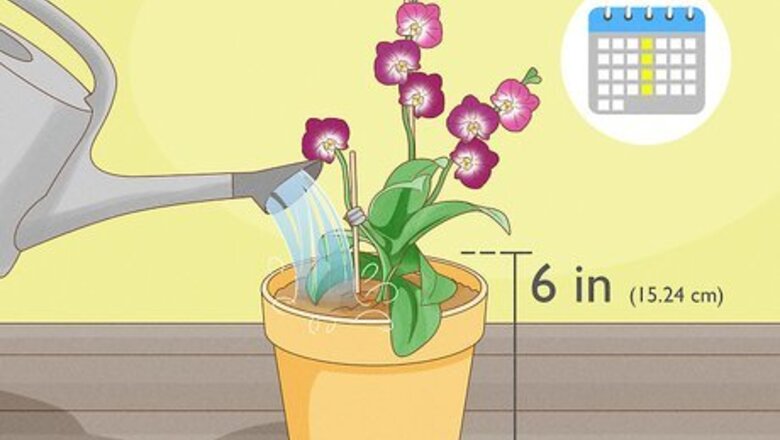
views
- Water your mini orchids once a week when the soil feels completely dry to the touch. Let the excess water drain out from the holes in the pot.
- Keep your orchids in an east-facing window so they’re out of direct sunlight. Maintain temperatures around 65–85 °F (18–29 °C) and humidity levels at 50%.
- Apply a ¼-strength dilute of 20-20-20 fertilizer each week after you water your orchids to provide nutrients throughout the growing season.
Basic Growing Requirements
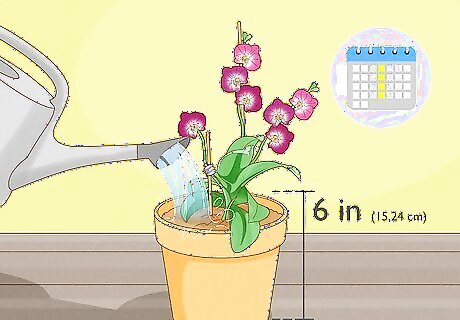
Water your mini orchids once a week when the potting medium dries out. Stick your finger or the point of a sharpened pencil 2 in (5.1 cm) into the potting medium. If the soil still feels wet, then leave your mini orchids alone for now. If the soil is dry, water your plant by pouring about 1.5 fluid ounces (44 ml) directly onto the soil. Let the water move through the potting medium and let the excess drain out from the bottom of your pot. Alternatively, set the pot in a bowl of water and let it sit for 15 minutes. Then, lift the pot out of the bowl and let the excess water all drain out. You may also quickly flush running water through the top of the pot for a few seconds and let it drain out. Overwatering can cause the roots to get soggy and kill your mini orchid, so always wait until the soil feels dry. Water phalaenopsis and paphiopedilum mini orchids just before the soil completely dries out. For cattleyas and oncidiums, let the soil get completely dry between waterings. Even though it’s a popular trend, avoid watering your orchid with ice because the freezing cold can stress or damage the plant, which could decrease its lifespan. During the winter months, reduce how much you water so the soil just feels damp.
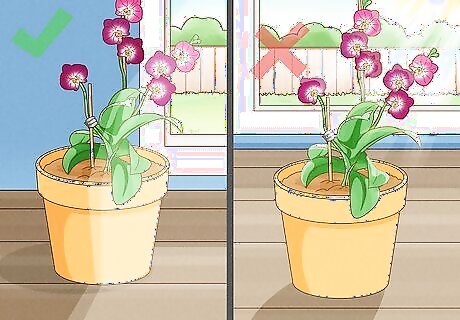
Keep your orchids near an east-facing window out of direct sunlight. Place your flowers about 3–5 ft (0.91–1.52 m) away from an eastern window so they only receive muted sun. Direct sunlight could cause your orchids to overheat and get sun-damaged otherwise. When your orchids receive enough light, the leaves will look light and golden green. Dark green leaves mean your orchids need more light while yellow or red leaves mean they’re receiving too much. Use fluorescent grow lights or high-intensity discharge lights if you don’t have a suitable place for your orchids. Position the lights 6–12 in (15–30 cm) away from the top of your mini orchids to prevent them from getting too much light. Alternatively, place your mini orchids in a south-facing window and block out some of the direct sun with a translucent shade or screen in a southern window.
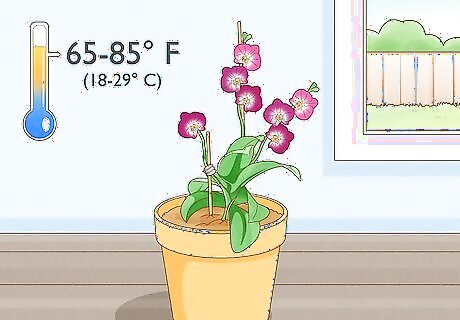
Maintain a room temperature between 65–85 °F (18–29 °C). Mini orchids are tropical plants, so they thrive in warmer conditions. For best results, maintain the temperature on the high end of the scale during the day and drop it to the lower end in the evenings. Never allow the temperature to drop below 55 °F (13 °C) since this could stress out your flowers and keep them from blooming.
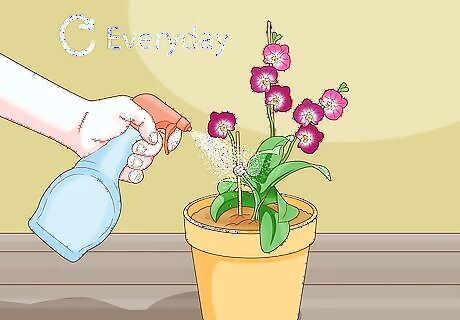
Keep the mini orchids at around 50% humidity. Mini orchids thrive in humid conditions, so try lightly misting the plant every 1–2 days to help increase the humidity. Alternatively, set a tray of pebbles and water underneath the water to naturally increase the humidity. If you need to raise the humidity even more for your orchids, run a humidifier in the same room during the day. Keep a humidity meter near your flowers so you can easily track the moisture levels in the air. Avoid leaving your flowers near open windows or air vents since it could reduce the humidity around the orchids.
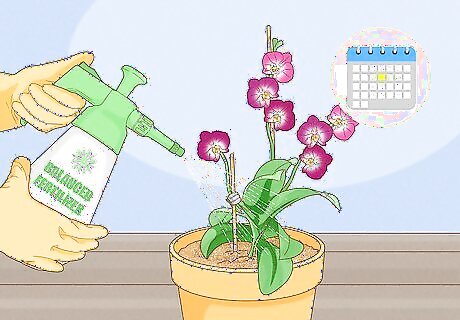
Fertilize your mini orchid weekly with a diluted 20-20-20 mix. Use a fertilizer mix that’s urea-free and has a balanced mix of nitrogen, phosphorus, and potassium. Mix 1 part fertilizer with 3 parts water to dilute the mixture to ¼-strength. Each week after you water your mini orchids, follow up with the diluted fertilizer to ensure the flowers grow in strong and healthy. Avoid giving your orchids fertilizer when the soil is dry since you could burn the roots and prevent them from absorbing water or nutrients. Skip fertilizing your orchids during the winter months when they’re not actively growing so you don’t stress out your plant.
Pruning
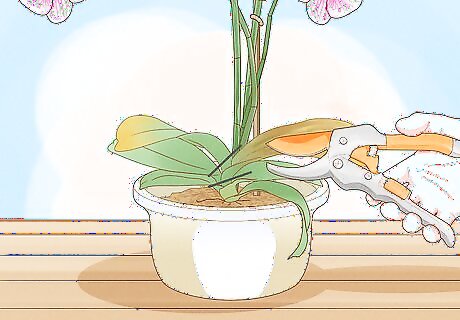
Deadhead dried leaves when you see them. Mini orchids require almost no pruning, but removing old leaves can redirect the plant’s energy to healthy growth. When you notice that leaves are turning brown, use a clean gardening knife to slice the growths off as close to the stem as possible. Avoid removing any leaves that still look healthy since they may still provide water and nutrients to new growths on your mini orchids.
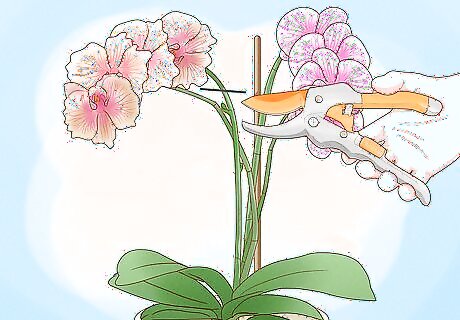
Prune phalaenopsis orchids above the stem’s second node for more blooms. Phalaenopsis, also known as teacup or darling orchids, is the only type of orchid that can bloom twice during the same growing season. Once the flowers dry out and shrivel, gently twist them to remove them from the stem. Then, use a sharp knife or gardening shears to cut just above the second node, which is where leaves or flowers grow from the stem. Within a few weeks, your orchid will have a second round of flowers. If you leave phalaenopsis orchids without cutting them, flowers may grow back in the same spots as the old ones, but they may not get as large as before. Mini piccola, cattleya, and cymbidium orchids only bloom once for the season, so they won’t rebloom if you try pruning them.
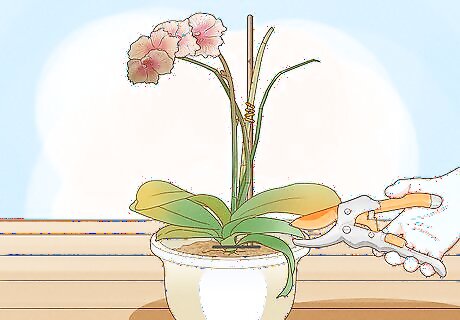
Cut the stems down to the base when your orchids finish blooming. Once all the flowers have dried out and shriveled on the first or second bloom, your orchid is done flowering until the next season. Use a sharp pair of pruning shears to cut the stems back down to the soil. During the next season, your orchids will grow back in and have new blooms.
Repotting
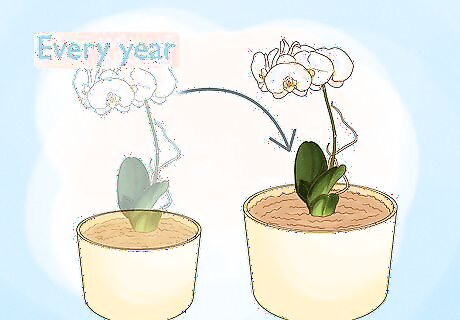
Move your mini orchids to a larger pot every year. Mini orchids have fast-growing roots, so a yearly repotting helps ensure your plant stays happy and healthy. If you notice that leaves are dying out more quickly or that “air roots” are growing out from the pot’s drainage holes or above the soil, then it’s time to repot your plant. Leaving your orchids in the same pot could stress the roots and make them brown or soggy.
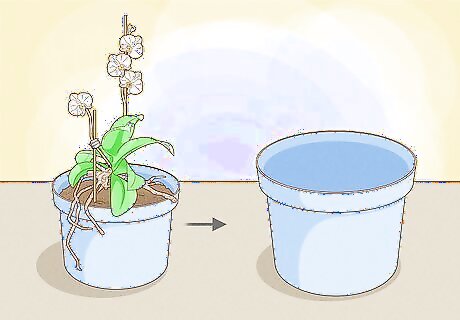
Get a well-draining pot that’s 1–2 in (2.5–5.1 cm) wider than the old one. Mini orchids have fast-growing roots, but they don’t like to be compact inside of the pot. Measure the pot that your orchid is currently planted in, and choose a slightly larger one for repotting. Make sure the pot has drainage holes at the bottom so water can drip out and prevent the roots from becoming soggy. Avoid choosing pots that are much larger than the original, or your flowers will put more energy into growing roots instead of blooms.
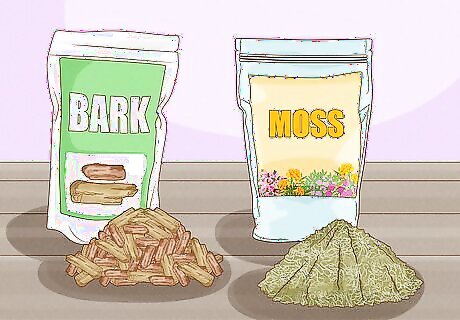
Wet an orchid mix with boiling water. Choose a pre-packaged mix made for orchids, or try using sphagnum moss or bark mix. Place the potting medium you chose into a large bucket, and boil twice as much water in a pot on your stove. Pour the boiling water into the potting mix and stir it together. Let the mix absorb the water and come to room temperature. After that, drain out any excess water. The boiling water helps kill any bacteria that’s present in the potting mix. Avoid using standard potting soil since it doesn’t allow as much airflow and could make your orchids get waterlogged.
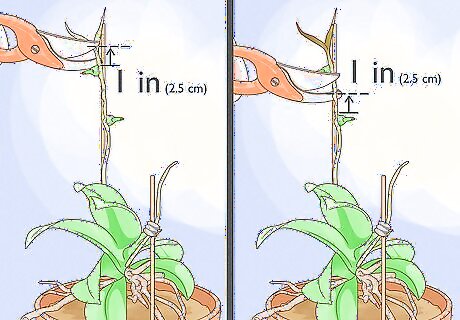
Trim the spikes above the top or bottom node. The spikes are the tall solid stems where the flowers grow and bloom. If the spikes still look green and healthy, snip 1 inch (2.5 cm) above the top-most node on the stem. When the spikes look yellow or brown spikes, then cut them 1 inch (2.5 cm) above the bottom node instead.
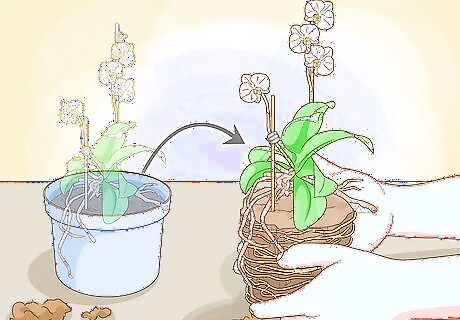
Remove the mini orchid carefully from its current container. Gently squeeze the sides of the orchid’s current pot to help loosen up the roots and potting mix. Then, gently grab the base of the orchid with one hand and the pot with your other. Tip the mini orchid to its side or upside-down, and slowly squeeze or rotate the sides of the pot until the clump of roots comes free. Try not to pull the orchid straight up and out of the pot since you’re more likely to damage the roots or leaves.
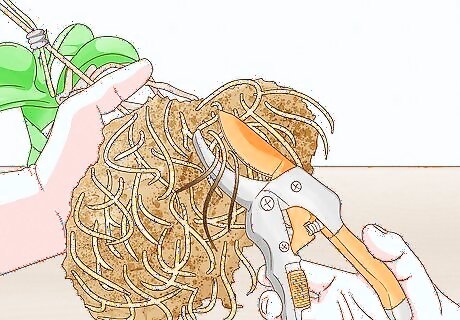
Remove the old potting mix and dead roots from the root ball. Use your fingers or a stiff-bristled brush to gently break apart as much potting mix from between the roots as you can. If you notice any roots that look brown, black, or wilted, use a pair of gardening shears to trim away the unhealthy growths. Leave healthy roots that are white or green and feel firm so your orchids can grow in strong in the new pot. Keeping old potting mix between the orchid’s roots can increase the chances of rot forming.
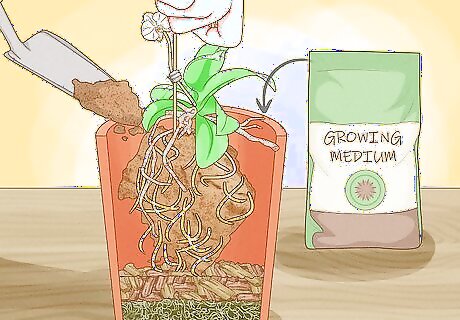
Move your orchids into the new container with the potting mix. Scoop some of the potting mix you soaked into the bottom of the pot as the base layer. Then, set your orchid in the middle of the pot so that the base of the lowest leaf dips below the pot’s rim by ⁄2 inch (1.3 cm). Slowly add the remaining potting mix around the orchids to fill in the container until the entire root system is covered. Periodically tap the side of the container with your hand to help the potting mix settle it. Try gently lifting the orchids up by the stem after filling in the potting mix. If the pot starts to slip, add more mix and gently pat it down to make the orchid fit more securely.
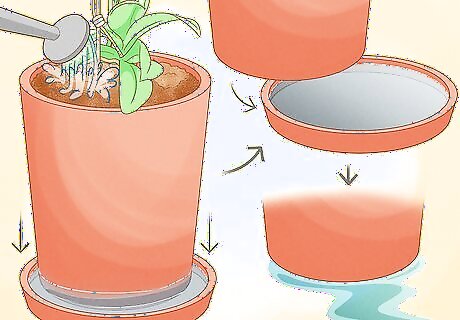
Water your orchids lightly. Set your orchid inside of another pot or on a saucer and pour water onto the potting mix until it’s full. Let the orchids sit in the water for about 10 minutes before removing the container and letting the excess water drip out from the drainage holes. Avoid letting the orchids sit in the water for any longer since they may become waterlogged and root rot may form.




















Comments
0 comment